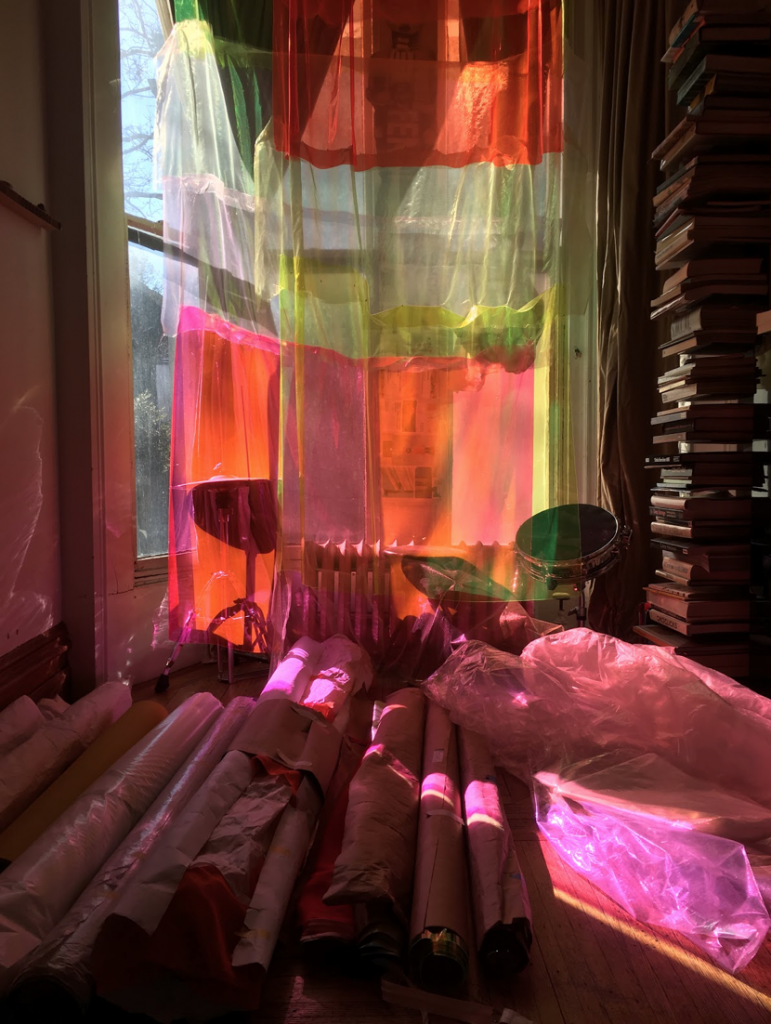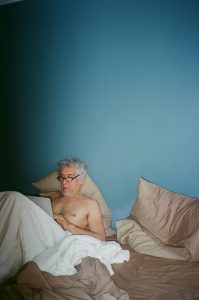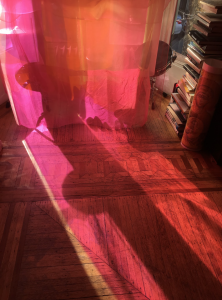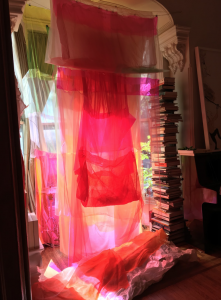
The light that shines through the translucent plastic is viciously sensual. The sun permeates the material and projects a candy colored pink shadow onto the wooden floor, met with varying shades of effervescent lime, intrepid orange, and delicate violet. The radiant shadows dance with one another, shifting in hue and intensity as the outside light moves from dawn to dusk.
A ten foot by four foot patchwork of pellucid materials sewn together hangs from the bay window of a brownstone in Park Slope, Brooklyn. This is the work of Marc Lafia, an artist that has made his studio the bottom floor of his family home.
It is a quiet Thursday afternoon and the studio is vacant: not of the art, but of the artist. It is rare to experience the space without the emanating presence of Marc, who spends most days working, writing, and creating art in the various rooms of his atelier. As he innovates, he unearths himself.
Marc’s art practice is iterative and perpetually blossoming. He’s like a conductor of a massive orchestra that he is constantly recasting, refining, and expanding. His musicians take the form of any and every material that one could imagine: sheets of silicon, latex, silk, diaphanous plastic, giant gauze, organza, metallic mylar, wooden cubes, cardboard, sheer cloth, tissue paper, textiles, zippers, pliable string, potato sacks, felt, zip lock bags, and more. The list is infinite. Marc decides how these materials will come together to form works of art, sometimes in duets, sometimes in quartets, and most often in symphonies.
A few days each week, Marc roams the aisles of Canal Plastics and Mood Fabrics, two of his go-to stores in Lower Manhattan. He can spend hours observing the highly industrialized and refined products that line the shelves of these emporiums, touching every piece of neoprene or acrylic he comes across. He examines the materials by feeling them, touching them, scrutinizing their various sizes, weights, shapes, and textures. Sometimes he knows what he is looking for, but often what he brings home is different from what he set out to buy.
Perhaps that is an apt parallel for Marc’s style as an artist. That is not to say that his work is random: not at all. It is deliberately eclectic. He knows, but he doesn’t know. He is perceptive and reflective, thinking deeply about his ideas, claims, and desires, but he often translates these preconceptions into tangible realities via of-the-moment discoveries. His work ethic is deeply in touch with the present, with his surroundings and his environment, with the materials he has at hand, with the weather of the day, with the light of the hour.
Marc’s ever expanding toolkit of raw materials are more than just a response to his artistic visions. In fact, for him, that link is actually reversed: it is the materials themselves that garner his vision. His work certainly requires cavernous rumination, but not without the help of a physical substrate laying before his eyes to help propel his thinking forward. He will admit, and proudly so, that his materials often dictate his ideas.
______
The next morning, a brisk December Friday, he embarks on his daily routine of waking up with the sun and walking downstairs to retrieve hot coffee with steamed milk in a mossy green mug. He then returns to his bedroom, sinks into his mattress as he leans against the blue-gray colored wall, and opens the “Notes” application on his computer. Here he keeps hundreds of documents of essays, moodboards, and nuggets of thought about his current body of work, which has yet to have a definite title. It oscillates between “In What Language to Come,” “Forms, Appearances, and Representations,” and “Experience of the Pleasant, of Reward, and of the Beautiful.”

He spends the next few hours writing away, perhaps energized by his eccentric dream from the previous night. Marc is an avid and vivid dreamer, each night bringing a new discovery, terror, realization, or experience for him. He likes to stress that he dreams in intense color. In his last slumber, his escapade began by him walking down a hill of lusciously green grass. He says he came across a deep, dark, bottomless, aquamarine, reflective blue lake. A crisp white convertible car was dripping water in slow motion as it was pulled up by a bright orange crane. A massive crowd of people gathered to watch, and they were all wearing glossy yellow raincoats.
Though he tries not to take the content of his dreams too seriously, it is the arresting colors that stick with him throughout the day. Around 10am, he dresses in one of three typical outfits: an all white ensemble, a blue pinstripe button down shirt coupled with black trousers, or a fabulously patterned shirt paired with hazelnut colored corduroys. The constants of each day’s attire include a bedazzled black belt and a dainty neck scarf. He also always wears two beaded bracelets, one blue and one black, that were made and gifted to him in Japan two summers ago by the mother of a good friend of his, a fellow artist herself. The mother passed away a few months following Marc’s visit to her home in Tokyo, and he has worn the bracelets daily ever since.
Marc descends the two flights of stairs from his bedroom to the bottom floor, stopping briefly in the kitchen for a handful of salted nuts. He slips on his caramel brown Turkish slippers–that are so worn they need orange duct-tape to keep them from falling apart–as he crosses the threshold of his studio. The room is freezing–he calls it his “winter palace”–but he is immune to this arctic cold since he spends nearly every day in it. Sometimes he lights a fire in the backroom fireplace, which adds to the natural, earthy feeling of his space. Still, his resistance to the cold isn’t strong enough to stop him from putting on a thin black jacket for imperative warmth.
The particular brownstone inside which he has built his studio is a unique space because it is a corner house, and thus has sixteen windows on the parlor floor alone. “To me it’s like an amazing, massive camera,” Marc describes. “You’re getting almost four sides of light.”
His sensitivity to light is deeply ingrained within him, likely formed by his background in photography and film. Although his career path shifted to fine art fifteen years ago, his time in film school and utter love of photography have been integral in forming how he experiences the world, and in turn how he experiences and thus creates art. Marc’s mind is always thinking of different “shots,” constantly constructing a story and a documenting a narrative as he goes about his day, just as he was trained to do as a filmmaker. He does not passively standby and watch reality unfold, but rather actively experiences thing with an eye trained to preserve content that might be perfect material for a later project. In this vein, Marc is the epitome of a metacognitive person and thinker: in fact, one could say that he is a metacognitive connoisseur. He is always stepping back to think about how he is thinking, how he is doing what he is doing, how he is responding to the things that he feeling. His cinematic mind has become intrinsic, morphing into a philosophical locomotive that critically thinks and makes in tandem.
Marc’s current work is perhaps the culmination of years and years of retaliation against photography as it is most typically known. As someone who lived through the transition from the analog to the digital, he has become acutely attune to form. He is obsessed with the how of things, anything, more so than the what or the why. He grew up with the restriction of 35 shots on a roll of film that would take days to get developed, and fifty years later he has an iPhone with 64 gigabytes of storage that allows him to take thousands upon thousands of pictures that he can view instantly. Having witnessed such a rapid transition and expansion of the capabilities of a camera, Marc is fascinated by what a picture was, what a picture is, and what a picture can be. Evidence of this interest is clear in the titles of his last and current books: “Image Photograph,” and “The Event of Art,” respectively.
“One of the things that interested me when I was doing a lot of photography was the physical act of printing the photographs,” Marc recollects. He goes onto describe how he’d go to galleries and play close attention to the frame that a photograph was placed in, the size of the image, the paper it was printed on, and so on. This led him to the profound realization that a photograph is also an object, a claim that he has since been working on for years on end.
“I wanted to make an image with a new kind of substrate,” he declares. That desire transpired a few years ago when Marc began to print photographs onto paper lampshades from Ikea. He found interesting ties between this new work and the traditional medium of photography when he happily remembered that all negatives are plastic–analog film is plastic, so the physical existence of a “photograph” is enabled by a palpable material.
That was the beginning of a very organic progression of zealous work for Marc, all budding and building and growing from an underlying desire to discover and create a new form of photography. He started venturing to fabric stores, on a mission to discover the possibilities that materials of all kinds would lead him to.
He started with sewing the Ikea lamp shades to a piece of colored plastic, and hung it up in his studio as a kind of experiment. He waited for the afternoon light to hit, and all of a sudden the newly made sculpture began to glow. This was his first iteration of a new kind of material “photograph.”
It’s no wonder that Marc has been making work that encompasses light, because the way that the sun gushes and blushes and bursts through the windows of his studio would fill anyone with exuberance. The late afternoon light in particular, which hits the front, western side of the room, is sure to galvanize a visceral reaction. Each hour of the day fills his studio with a different sensitivity of ambient light
Marc walks up to the pink, sheer cloth that hangs from a clothesline-like structure in the center of the room, examining it by way of touching it. He picks up a larger piece of fabric, composed of several smaller pieces sewn together, and fastens it to an opening further down the clothesline.
It is a day in which the sun’s desire to shine is constantly wavering. One moment the sky is overcast, and the next the sun is beaming. It is during the latter that the art in the room is at its peak. A leisurely, observant meander throughout the studio reveals a myriad of shadows in every nook and cranny. Fabric pieces are hung all around the room, creating projections of light that are variable, fluctuating, mercurial, volatile, fluid, shifting.
After his first fabric experiment, he coined the term “light-sculpture,” and began making a multitude of them. “These fabrics are light sculptures in the sense that they are light sensitive, made with various kinds of plastic and polyesters,” he explains. “Each material has a different kind of opacity, transparency, and color that emits light; that lets light moves forward; that lets shards of sun ripple through.” With each new piece, he continues to explore his fascination with what happens when light is enclosed, enraptured, and held within itself. “It’s kind of like an adventure that gets very obsessive. You just keep going with it, you follow it, and it takes you where it wants to go. That’s the whole point, and that’s what I love about it.”
His studio is now full of light sculptures of all shapes and sizes and colors, all of which refract and transpose light in different ways. The way that the fabrics fold and mold into each other feels organic and animate, as if the sculptures themselves are living and breathing just like we are. “They are very alive.”



His work reminds the viewer of something, but they are not sure exactly what it is. “It’s very oblique in a way.” The viewer wants to touch them, or at least imagine what the various materials feel like. “I want to step back from depiction, representation, and imitation, and present things as phenomena itself. From there, I can open up a space to give view to materiality and form as an object itself.”
Marc’s work fluid, ephemeral, and ever changing. He says that he’s been trying to make something that changes as you move about it, something that sees you more than you see it. He wants to evoke a relationship between “the perceiver, and the embodied perception.” At the same time, his new work is very much about fragility, a kind of “frozen calamity physics,” as he describes. To him, it’s all about the things that are about to fall apart, and yet precariously stay together. He adamantly disagrees with the common perception that art is permanent, that it defeats time and can exist forever. For Marc, art is an experience of the moment. He is inspired by painter Marcelle Duchamp and musician John Cage, who were both interested in the idea of variability and chance. One of Marc’s essential mantras is from a Mallarmé poem: “a throw of the dice does not abolish chance.” He says that he still doesn’t quite understand what the phrase means, but he loves it nonetheless. Marc seems to be increasingly interested in dichotomies: how we as people are both so strong and so frail. He tries to echo this paradox in his work.
________
Evening comes, and Marc sits on his red reef couch in the back room of the studio reading an article called “Art and Its Surrogates.” Morrissey, his favorite musician, is blasting on speakers. He listens to “Mountjoy” over and over and over again, singing along to the lyric, “The joy brings many things, but it cannot bring you joy.”
He looks up towards his sculptures, which hang about the space without the presence of light. They are resting, sleeping, unwinding. Getting ready for tomorrow, for another day of luminescent variability.
“You can make art with your family, in your house, on an airplane, at the beach. You can make art, do art, be art, act art. You ARE art. Art has a fullness and a robustness that is everbecoming. It’s really fun.”
His orchestra tunes its instruments, and their conductor falls into a colorful dream.
